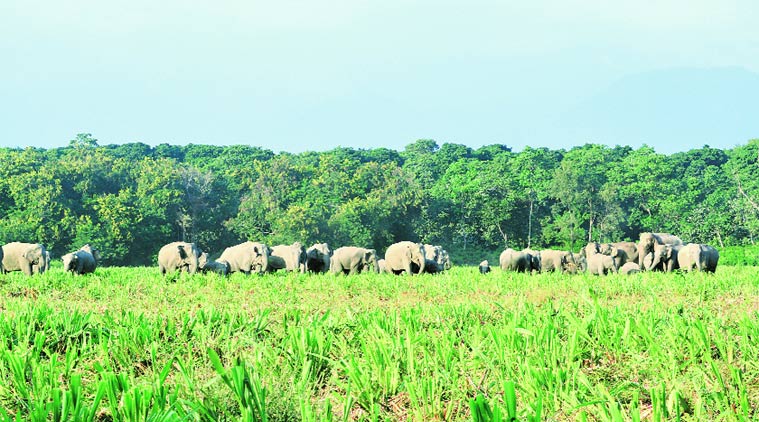- India
- International
Tea estates in Assam create natural corridors for elephants to pass through
Tea estates in Assam have created natural corridors for elephants to pass through in an attempt to reduce damage to the plantations and prevent loss of human life.
 A herd of elephants in Udalguri district, Assam, that borders Bhutan
A herd of elephants in Udalguri district, Assam, that borders Bhutan
Nonaipara is not a wildlife sanctuary. It is a tea estate adjoining the Dhansiri forest division right on the Indo-Bhutan border in Assam’s Udalguri district — and home to a number of animals, such as elephants, leopards, bison, spotted deer, wild boar and wolves. The billboard at the entrance provides you with a comprehensive list of flora and fauna in and around the 650-hectare estate, in addition to extracts from the Wildlife Protection Act that defines wild animals and prohibit hunting. Till a few years ago, the humans and the animals in Nonaipara lived harmoniously, with the exception of one lot — the elephants.
Elephants amidst the tea gardens are akin to bulls in a china shop; it is unlikely that a herd of the largest mammals on earth will daintily stroll through the area without casualties. “Three natural elephant corridors cut through our tea estate, with herds of elephants often passing through, sometimes causing lot of damage to the tea bushes. On a couple of occasions, we have also lost a few of our employees. Over the years, we have not only learned to adjust with the elephants and other wildlife, but also evolve strategies that have led to an almost peaceful co-existence with them,” says Parag Jyoti Das, senior manager at the tea estate.
Nonaipara, and several other tea estates such as Orangajuli, Corramore, Borengajuli, Attareekhat, Panery and Bhooteachang, are located amid a number of reserved forests that run across the international boundary into Bhutan. The Dhansiri forest division comprises three reserved forests — Khalingduar, Rowta and Bhairabkunda — and the Barnadi wildlife sanctuary, a part of the Ripu-Khalingduar Elephant Range, providing a large territory for the elephants to move about. But with rapid deforestation and shrinking habitats, elephants now often stray in search of food and shelter; in the process, they visit these tea estates, too.
 A baby elephant at the Nonaipara tea estate
A baby elephant at the Nonaipara tea estate
“There was a time when our labourers used to panic when they discovered a herd of elephants inside the plantation. They would come out, shout, beat drums, light fires, use bows and arrows and throw stones to scare the animals away,” says Das. “Nowadays, nobody disturbs a herd of elephants walking through the well-defined corridors. We have removed the tea bushes to clear a path for them. We urged the workers not to use poisoned arrows or pelt stones. Instead, they pray, and sing songs as the elephants pass by,” said Rajen Gogoi, senior assistant manager, Nonaipara. He has spent nearly three decades at various tea estates in the region and over the years, Gogoi has become something of an elephant expert and is knowledgeable about the different groups of elephants that arrive at the tea estates in different seasons.
“We play host to three distinct groups of elephants. The short, stout ones belong to the Bhutan hills. Bhutan is sparsely populated, they’re not particularly used to human presence so they are a very scared lot, bolting at the slightest provocation. That herd comprises 60 to 70 elephants and hardly stays for a week or so,” says Gogoi. The Assam herds walk through the tea estates into the neighbouring villages unafraid, enjoying ripe paddy and feasting on plantain trees; once in a while they raid granaries. “But the most aggressive and dangerous are the two or three herds that come down from Arunachal Pradesh. They are completely wild and do not follow the natural corridors unlike the other herds,” he says.

Nonaipara has also erected a solar-powered electric fence along its northern boundary to keep away elephants. “While a single stray elephant will retreat because of the mild electric shock, it is impossible to keep a herd out,” says Das. But the elephants do something interesting. As they approach the fence, one of them will touch the fence with its tail. If it feels a shock, it will break the branch of a nearby tree and bang it on the wire till it breaks. “Whenever we see a herd approaching, we remove the electric wires, so that there is minimum damage,” said Das.
Elephants on the Line (EOL), a local NGO that has been working with tea estates and local communities, is against using electric fence to keep away elephants. “We have suggested bio-fence, comprising citrus plants and bhot jolokia,” said Jayanta Das of EOL. Gogoi has developed chilli sticks — a paste of bhot jolokia (the world’s hottest chilli that is indigenous to Assam, Nagaland and Bhutan), tobacco leaves and cowdung — which when burnt, gives away a smoke that elephants dislike. “It is good, but you have to depend upon the direction of wind too,” points out Mubina Akhtar, a freelance environment journalist and a member of the Assam Wildlife Board.
“Experience has taught us that the elephants are very fond of certain types of shade trees like Albizzia sinensis, commonly called siris. “Now we are replacing them with Derris robusta, which they despise,” said A Rahman, manager, Orangajuli tea estate. Kinal Shekhawat of Corramore tea estate says that villagers are now growing alternative crops that do not attract elephants.
While the tea estates can afford to spend time and money in innovating ways to live with the elephants, the inhabitants of numerous adjoining villages are mostly left to themselves to face the arrival of a herd of wild elephants in the dead of night.
An adult elephant requires about 250 kg of food and 250 litres of water a day. “With forests rapidly disappearing and streams and water bodies drying up, it is quite natural for the hungry elephants to look for food in the nearby villages. Thus, they raid granaries, destroy kitchens and wipe out banana plantations, and also trample upon people who come in their way,” said Das of EOL. In the past three years, at least 50 villagers have been trampled to death by wild elephants in the district; people, have hit back too, killing at least 22 elephants.
Meanwhile, a young group of Bodo tribals has done something rather extraordinary. The recurrent flooding of the Dhansiri river had devastated a large portion of the Bhairabkunda reserved forest. A group of local youth constituted the Bhairabkunda Joint Forest Management Committee (JFMC), received funds and support from the Ministry of Environment and Forests, and regenerated the forest in such a way that it has now become a safe habitat for elephants, deer, leopards, boars and monkeys. “We are glad that villagers nearby are relatively free from elephant depredation,” says Esmail Daimary, secretary, JFMC.
The story appeared in print with the headline Beasts of the Eastern Wild
May 11: Latest News
- 01
- 02
- 03
- 04
- 05






































